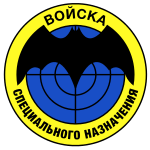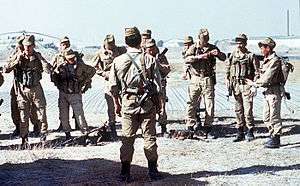Spetsnaz GRU
| Spetsnaz GRU | |
|---|---|
 | |
| Active | 1949–2012, 2013–present |
| Country |
1991–2010 (under the GRU) 2010–2012 (Non-GRU) 2013–present (under the GRU) |
| Branch |
|
| Type | Special Forces |
| Role |
Special reconnaissance Direct action |
| Size | Classified[1] |
| Part of |
(1949–1991) (1991–present) |
| GRU Headquarters | 76 Khoroshyovskoe shosse, Khodinka, Moscow |
| Mascot(s) | Bat |
| Engagements |
Cold War conflicts Soviet War in Afghanistan Civil War in Tajikistan East Prigorodny conflict War in Abkhazia First Chechen War Invasion of Dagestan Second Chechen War Insurgency in the North Caucasus Russo-Georgian War 2014 Russian military intervention in Ukraine Syrian civil war |
GRU Spetsnaz are the elite military formations under the control of the military intelligence service GRU. It was the first Soviet/Russian spetsnaz (special forces) force, more than two decades older than its KGB/FSB and MVD counterparts. The full acronym is GRU GSh (Russian: ГРУ ГШ) or Glavnoye Razvedyvatel'noye Upravleniye Generalnovo Shtaba (Russian: Главное Разведывательное Управление Генерального Штаба) meaning Main Intelligence Directorate of the General Staff (of the Russian Federation). The acronym, however, is usually shortened to just GRU (Russian: ГРУ) which stands for Glavnoye Razvedyvatel'noye Upravleniye (Russian: Главное Разведывательное Управление) (English: Main Intelligence Directorate). The word "Spetsnaz" is often written in all capital letters ("SPETSNAZ").
In 2010, following Russian military reforms, Spetsnaz GRU were disbanded and instead placed into different divisions of the Ground Forces of the Russian Military; in 2013, however, some units were reassigned to GRU divisions and placed under GRU authority once more.[2]
History

The concept of using special forces tactics and strategies was originally proposed by the Russian military theorist Mikhail Svechnykov (executed during the Great Purge in 1938), who envisaged the development of unconventional warfare capabilities in order to overcome disadvantages that conventional forces may face in the field. Practical implementation was begun by the "grandfather of the spetsnaz" Ilya Starinov. During World War II, reconnaissance and sabotage forces were formed under the supervision of the Second Department of the General Staff of the Soviet Armed Forces. These forces were subordinate to the commanders of Fronts.[3]
The situation was reviewed after the war ended, and between 1947 and 1950 the whole of GRU was reorganized.[4] The first 'independent reconnaissance companies of special purpose' were formed in 1949, to work for tank and combined-arms armies, which were tasked to eliminate amongst others enemy nuclear weapons systems such as the MGR-3 Little John and MGM-1 Matador.[4] In 1957, the first Spetsnaz battalions were formed, five to operate beyond the 150–200 km range of the reconnaissance companies. The first brigades were formed in 1962, reportedly to reach up to 750 kilometres in the rear to destroy U.S. weapons systems such as the MGM-52 Lance, MGM-29 Sergeant, and MGM-31 Pershing.[4] Two 'study regiments' were established in the 1960s to train specialists and NCOs, the first in 1968 at Pechora near Pskov, and the second in 1970 at Chirchik near Tashkent.[5] According to Vladimir Rezun, a GRU defector who used the pseudonym "Viktor Suvorov", there were 20 GRU Spetsnaz brigades plus 41 separate companies at the time of his defection in 1978.

The primary function of Spetsnaz troops in wartime was infiltration/insertion behind enemy lines (either in uniform or civilian clothing), usually well before hostilities are scheduled to begin and, once in place, to commit acts of sabotage (such as the destruction of vital NATO communications logistics centers) and the assassination of key government leaders and military officers.
During Soviet times, Spetsnaz GRU operatives would have to complete training that included the following: weapons handling, rappelling, explosives training, marksmanship, counter-terrorism, airborne training, hand-to-hand combat, climbing (alpine rope techniques), diving, underwater combat, long-range marksmanship, emergency medical training, and demolition.
Its operations included Operation Storm-333, the successful mission to kill the Afghan president in 1979. During the 2000s, ethnic-Chechen Special Battalions Vostok and Zapad existed.
Since 2009-2010, Spetsnaz GRU forces have been resubordinated, now attached to military districts of the Ground Forces of the Russian Federation[6] and subordinate to the operational-strategic commands, due to Anatoliy Serdyukov's military reforms. In 2011, it was announced that some former Spetsnaz GRU personnel might return under control of the General Staff of the Armed Forces of the Russian Federation in some form separate and distinct from GRU, and answering directly to the General Staff.
In 2013, several Spetsnaz units were returned to GRU authority as few were part of the more wider Special Operations Forces of the Russian Federation, established that year encompassing all Army, Airborne Troops and Navy spetnaz units and their training schools, under the control of the Ministry of Defense.
Listing of brigades
Below is a 2012 list of Spetsnaz units in the Russian Armed Forces:[7][8]
- Russian Ground Forces
- Western Military District
- 2nd Spetsnaz Brigade (obrSpN)
- 16th Spetsnaz Brigade (obrSpN)
- Southern Military District
- 10th Spetsnaz Brigade (obrSpN)
- 22nd Guards Spetsnaz Brigade (obrSpN)[9]
- 346th Spetsnaz Brigade (obrSpN)
- 25th Spetsnaz Regiment (opSpN)
- Central Military District
- 3rd Guards Spetsnaz Brigade (obrSpN)
- 24th Spetsnaz Brigade (obrSpN)
- Eastern Military District
- 14th Spetsnaz Brigade (obrSpN)
- Western Military District
- Russian Airborne Troops
- 45th Guards Spetsnaz Regiment (opSpN VDV)
- Russian Navy
- 42nd Naval Reconnaissance Spetsnaz Point (omrpSpN – Pacific Fleet)
- 420th Naval Reconnaissance Spetsnaz Point (omrpSpN – Northern Fleet)
- 431st Naval Reconnaissance Spetsnaz Point (omrpSpN – Black Sea Fleet)
- 561st Naval Reconnaissance Spetsnaz Point (omrpSpN – Baltic Fleet)
Spetsnaz weapons
Soviet Spetsnaz weaponry consisted of more streamlined, stripped-down weapons suitable for covert operations, such as the AKS-74U carbine. Modern Russian Spetsnaz weapons include the VSS Vintorez sniper rifle, AS Val assault rifle, SV98 sniper rifle, AK-9 assault rifle, AN-94 assault rifle, and the PP-19 Bizon submachine gun, along with older weaponry such as the AKS-74U. Specialized weaponry includes the NRS-2, a survival knife with a built-in single-shot firing mechanism able to fire a 7.62×42mm SP-4 cartridge (the same used in PSS Silent Pistol), along with the RPG-16 and plastic explosives; for urban warfare scenarios, the PKP Pecheneg LMG has also been used by Spetsnaz groups. Similar to other modern special forces organizations, Spetsnaz weaponry is selected by merit of stealth and reliability for special military operations, espionage, sabotage, or other covert actions.
References
- ↑ Spionage gegen Deutschland — Aktuelle Entwicklungen Stand: November 2008 (German)
- ↑ McDermott, Roger. "Bat or Mouse? The Strange Case of Reforming Spetsnaz". Jamestown.org. Retrieved 2014-08-19.
- ↑ Carey Schofield, The Russian Elite: Inside Spetsnaz and the Airborne Forces, Greenhill, London, 1993, p.34
- 1 2 3 Carey Schofield, The Russian Elite: Inside Spetsnaz and the Airborne Forces, Greenhill, London, 1993, p.35
- ↑ Carey Schofield, The Russian Elite: Inside Spetsnaz and the Airborne Forces, Greenhill, London, 1993, p.37
- ↑ United Nations High Commissioner for Refugees (2012-03-06). "Refworld | Putin's Military: Let the Good Times Roll". UNHCR. Retrieved 2014-08-19.
- ↑ ГРУ (Главное Разведывательное Управление) ГШ ВС РФ. Russian Military Analysis (in Russian). Retrieved December 30, 2012.
- ↑ Военно-Морской Флот. Russian Military Analysis (in Russian). Retrieved December 31, 2012.
- ↑ "Журнал для спецназа "Братишка" — Визитная карточка: ДВАДЦАТЬ ВТОРАЯ ГВАРДЕЙСКАЯ СПЕЦИАЛЬНОГО НАЗНАЧЕНИЯ". bratishka.ru.
Further reading
| Wikimedia Commons has media related to Spetsnaz. |
- Carey Schofield, The Russian Elite: Inside Spetsnaz and the Airborne Forces, Greenhill, London, 1993
- Scott and Scott, The Armed Forces of the Soviet Union
- Viktor Suvorov, Spetsnaz: The Story Behind the Soviet SAS, 1987, Hamish Hamilton Ltd, ISBN 0-241-11961-8
- Steve Zaloga, James W. Loop, Soviet Bloc Elite Forces, Volume 5 of Elite Series, Osprey Publishing, 1985, ISBN 0850456312, 9780850456318